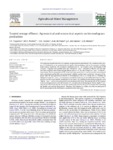Por favor, use este identificador para citar o enlazar este ítem:
http://www.alice.cnptia.embrapa.br/alice/handle/doc/932733Registro completo de metadatos
| Campo DC | Valor | Lengua/Idioma |
|---|---|---|
| dc.contributor.author | NOGUEIRA, S. F. | pt_BR |
| dc.contributor.author | PEREIRA, B. F. F. | pt_BR |
| dc.contributor.author | GOMES, T. M. | pt_BR |
| dc.contributor.author | DE PAULA, A. M. | pt_BR |
| dc.contributor.author | SANTOS, J. A. DOS | pt_BR |
| dc.contributor.author | MONTES, C. R. | pt_BR |
| dc.date.accessioned | 2015-02-25T10:28:44Z | - |
| dc.date.available | 2015-02-25T10:28:44Z | - |
| dc.date.created | 2012-08-31 | pt_BR |
| dc.date.issued | 2012 | pt_BR |
| dc.identifier.citation | Agricultural Water Management, v. 116, p. 151-159, 2012. | pt_BR |
| dc.identifier.isbn | 0378-3774 | pt_BR |
| dc.identifier.uri | http://www.alice.cnptia.embrapa.br/alice/handle/doc/932733 | pt_BR |
| dc.description | This study investigated the effects of irrigation using treated sewage effluent (TSE) combined with nitrogen (N) fertilization on the productivity and quality of bermudagrass, and on its economic feasibility under tropical conditions. The treatments employed were SI – no irrigation and no fertilization; A100 (control) – irrigation with potable water plus 520 kg N ha−1 year−1 provided as NH4NO3; E0, E33, E66, and E100: irrigation with treated sewage effluent plus 0, 172, 343 and 520 kg N ha−1 year−1 as NH4NO3, respectively. Chemical properties of TSE, shoot dry matter production, N concentration in bermudagrass were determined, and benefit–cost and economic viability analyses were carried out. Tree years of irrigation with TSE had agronomical benefits to bermudagrass such as: (i) saving 33% in N fertilizer by adding of 275 kg N ha−1 year−1, increasing N accumulation in the soil; (ii) providing 70% of the N as NH4 +, which is the form most quickly assimilated by the plants; (iii) building up dry matter production with 7 Mg ha−1 year−1 and (iv) increasing leaf N concentration in leaf tissue. The main benefit of TSE irrigation occurs in drought seasons with the increase in N concentration in bermudagrass shoots. Higher N concentration in leaf tissue elevates the quality and the sales price for the grass harvested, thus optimizing the benefit–cost ratio for the producer. Therefore, TSE irrigation is a viable cost-effective alternative if the N concentration in the leaf tissue is considered in the sales price. | pt_BR |
| dc.language.iso | eng | eng |
| dc.rights | openAccess | eng |
| dc.subject | Reclaimed wastewater | pt_BR |
| dc.subject | Bermudagrass | pt_BR |
| dc.title | Treated sewage effluent: Agronomical and economical aspects on bermudagrass production. | pt_BR |
| dc.type | Artigo de periódico | pt_BR |
| dc.date.updated | 2015-02-25T10:28:44Z | pt_BR |
| dc.subject.nalthesaurus | Sewage effluent | pt_BR |
| dc.subject.nalthesaurus | Water reuse | pt_BR |
| dc.subject.nalthesaurus | Plant nutrition | pt_BR |
| dc.subject.nalthesaurus | Nitrogen | pt_BR |
| riaa.ainfo.id | 932733 | pt_BR |
| riaa.ainfo.lastupdate | 2015-02-24 | pt_BR |
| dc.identifier.doi | http://dx.doi.org/10.1016/j.agwat.2012.07.005 | pt_BR |
| dc.contributor.institution | SANDRA FURLAN NOGUEIRA, CNPM; B. F. F. PEREIRA, UFAM; T. M. GOMES, USP; A. M. DE PAULA, UFPR; J. A. DOS SANTOS, USP; C. R. MONTES, USP. | pt_BR |
| Aparece en las colecciones: | Artigo em periódico indexado (CNPM)  | |
Ficheros en este ítem:
| Fichero | Descripción | Tamaño | Formato | |
|---|---|---|---|---|
| 3373.pdf | 839.45 kB | Adobe PDF |  Visualizar/Abrir |









